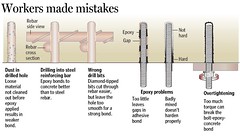Transit #2 -- outsourcing vs. building internal capacity and accountability
 Boston Globe graphics.
Boston Globe graphics.Today's Boston Globe has a chilling story about the ceiling collapse in the Central Artery Tunnel, "Cheaper, faster path led to failurer." From the article:
A five-month Boston Globe investigation shows that conservative engineering was the first casualty in the Interstate 90 connector tunnel as Big Dig costs rapidly escalated in the late 1990s. Under unrelenting pressure to save time and money, engineers from Gannett Fleming and Bechtel/Parsons Brinckerhoff, a joint venture hired by the state to manage the Big Dig, repeatedly weakened the ceiling's design, increasing the risk that the bolts would give out. Bechtel/Parsons Brinckerhoff decided to use concrete ceiling panels that were quicker to install and cheaper than the lighter ones used in the adjacent Ted Williams Tunnel, but more than twice as heavy.
Next, Big Dig managers successfully pressured Gannett Fleming to reduce by 40 percent the number of bolts used to hold up the ceiling.
Then, Gannett Fleming estimated each of the remaining bolts would have to hold far less weight than Tsikouras first estimated, leading them to recommend a bolt-safety test using less than half as much weight as that performed on the Ted Williams ceiling bolts.

While reading it, I was thinking of Paul Krugman's New York Times column from the other day, "Outsourcer in Chief," where he writes about the Bush Administration:
... outsourcing of the government’s responsibilities — not to panels of supposed wise men, but to private companies with the right connections — has been one of the hallmarks of his administration. And privatization through outsourcing is one reason the administration has failed on so many fronts...
It’s now clear that there’s a fundamental error in the antigovernment ideology embraced by today’s conservative movement. Conservatives look at the virtues of market competition and leap to the conclusion that private ownership, in itself, is some kind of magic elixir. But there’s no reason to assume that a private company hired to perform a public service will do better than people employed directly by the government.
In fact, the private company will almost surely do a worse job if its political connections insulate it from accountability .... Underlying this lack of accountability are the real motives for turning government functions over to private companies, which have little to do with efficiency. To say the obvious: when you see a story about failed outsourcing, you can be sure that the company in question is a major contributor to the Republican Party, is run by people with strong G.O.P. connections, or both.
While Krugman is writing about the federal government and the Republican administration of George W. Bush, the points he makes about crony capitalism and the feeding trough of government contracting pertain just as much to Democrats, and at all levels of government.
Where these two articles link up is in the transit planning foisted on the WMATA system by the State of Virginia, which has contracted with a group of companies, including Bechtel, one of the lead contractors for the Big Dig in Boston, to do the engineering and construction of the Dulles Metrorail extension. WMATA is not in charge.
I hope that WMATA signs a contract with Virginia that protects WMATA in case of catastrophic failure down the road.
Not to mention that Virginia's going their own way on this project means that Bechtel and other contractors build their expertise on the state's dime, when that expertise could have been captured and retained within the planning and engineering departments of WMATA, and then applied to other projects in the region. Furthermore, as I wrote in "Blinking on urban design means you limit your chance for success," their conceptualization of this project as a spur from East Falls Church means that other system capacity issues--such as the Rosslyn Tunnel-are not being addressed, and they could have been within the context of this project.
Also see:
-- Riding on (and capacity of) the Metro
-- The "Downtown" Circulator and Rosslyn, Virginia
-- Speaking of Political Leadership

Index Keywords: transit; government-contracting



0 Comments:
Post a Comment
<< Home